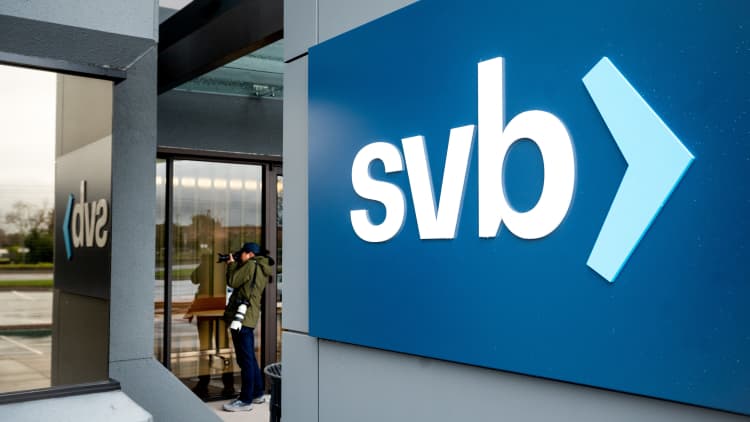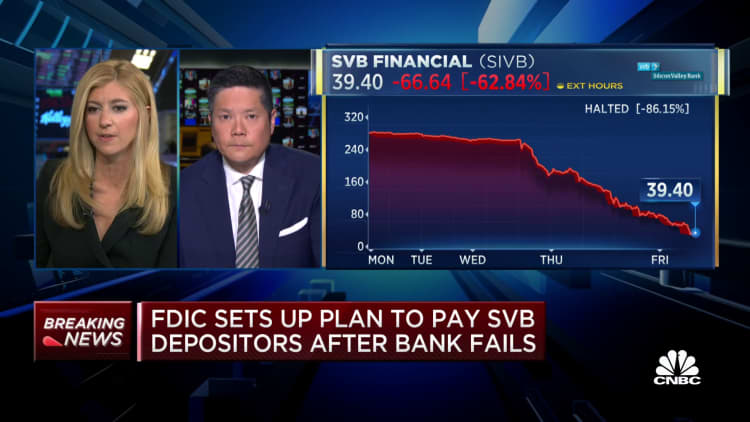[ad_1]

Financial regulators have closed Silicon Valley Bank and taken control of its deposits, the Federal Deposit Insurance Corp. announced Friday, in what is the largest U.S. bank failure since the global financial crisis more than a decade ago.
The collapse of SVB, a key player in the tech and venture capital community, leaves companies and wealthy individuals largely unsure of what will happen to their money.
According to press releases from regulators, the California Department of Financial Protection and Innovation closed SVB and named the FDIC as the receiver. The FDIC in turn has created the Deposit Insurance National Bank of Santa Clara, which now holds the insured deposits from SVB.

The FDIC said in the announcement that insured depositors will have access to their deposits no later than Monday morning. SVB’s branch offices will also reopen at that time, under the control of the regulator.
According to the press release, SVB’s official checks will continue to clear.
A Brinks armored truck sits parked in front of the shuttered Silicon Valley Bank (SVB) headquarters on March 10, 2023 in Santa Clara, California.
Justin Sullivan | Getty Images
The FDIC’s standard insurance covers up to $250,000 per depositor, per bank, for each account ownership category. The FDIC said uninsured depositors will get receivership certificates for their balances. The regulator said it will pay uninsured depositors an advanced dividend within the next week, with potential additional dividend payments as the regulator sells SVB’s assets.
Whether depositors with more than $250,000 ultimately get all their money back will be determined by the amount of money the regulator gets as it sells Silicon Valley assets or if another bank takes ownership of the remaining assets. There were concerns in the tech community that until that process unfolds, some companies may have issues making payroll.
As of the end of December, SVB had roughly $209 billion in total assets and $175.4 billion in total deposits, according to the press release. The FDIC said it was unclear what portion of those deposits were above the insurance limit.
The last U.S. bank failure of this size was Washington Mutual in 2008, which had $307 billion in assets.
Biggest bank failures since 2001
| Bank | Assets | Deposits |
|---|---|---|
| Washington Mutual | $307 billion | $188 billion |
| Silicon Valley Bank | $212 billion | $173 billion |
| IndyMac | $32 billion | $19 billion |
| Colonial Bank | $25 billion | $20 billion |
| Guaranty Bank | $13 billion | $12 billion |
Source: FDIC/FactSet
SVB was a major bank for venture-backed companies, which were already under pressure due to higher interest rates and a slowdown for initial public offerings that made it more difficult to raise additional cash.
The closure of SVB would impact not only the deposits, but also credit facilities and other forms of financing. The FDIC said loan customers of SVB should continue to make their payments as normal.
The move represents a rapid downfall for SVB. On Wednesday, the bank announced it was looking to raise more than $2 billion in additional capital after suffering a $1.8 billion loss on asset sales.
A notice hangs on the door of Silicon Valley Bank located in San Francisco, California, U.S. March 10, 2023.
Staff | Reuters
The shares of parent company SVB Financial Group fell 60% Thursday, and dropped another 60% in premarket trading Friday before being halted.
CNBC’s David Faber reported Friday morning that the efforts to raise capital had failed and that SVB had pivoted toward a potential sale. However, a rapid outflow of deposits was complicating the sale process.
While many Wall Street analysts have argued that the struggles for SVB are unlikely to spread to the broader banking system, shares of other midsized and regional banks came under pressure Friday.
Treasury Secretary Janet Yellen said during testimony before the House Ways and Means Committee on Friday morning that she was “monitoring very carefully” developments at a few banks. Yellen made her comments before the FDIC announcement.
Shortly after leaving Capitol Hill, Yellen convened a meeting of top officials at the Fed, the FDIC and the Comptroller of the Currency specifically to discuss the situation at SVB.
[ad_2]
Source link
